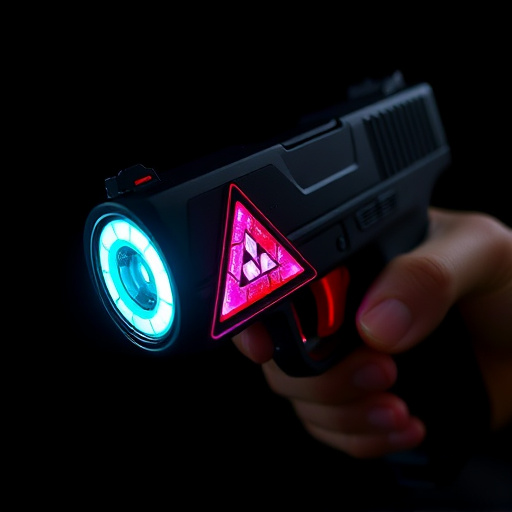Triad stun guns use advanced lithium-ion batteries with precise shock delivery, reusability, and quick charging times. When choosing batteries, consider voltage (higher for stronger jolts), capacity (determining runtime), and charging speed. Lithium-ion batteries offer superior energy density and lower self-discharge rates, while NiMH batteries are cost-effective. Proper maintenance through regular cleaning, optimal storage, and consistent charging ensures the triad stun gun's longevity as a personal safety tool.
“Uncover the power behind your defense with a deep dive into the rechargeable triad stun gun battery specifications. This comprehensive guide explores the core components that make these devices reliable companions for personal safety. From understanding the battery’s triad structure to deciphering vital specifications, you’ll learn what to look for in choosing the right fit. Discover common battery types and their unique advantages, plus essential maintenance tips to ensure longevity and optimal performance.”
- Understanding Triad Stun Gun Batteries: An Overview
- Key Battery Specifications to Consider
- Common Battery Types and Their Advantages
- Maintenance and Longevity: Ensuring Optimal Performance
Understanding Triad Stun Gun Batteries: An Overview
Stun guns, as self-defense tools, have evolved significantly, and at the heart of their performance lies the battery that powers them. Among the various types, triad stun gun batteries stand out for their advanced technology and efficient design. These batteries are crafted to meet the high demands of modern stun guns, offering a combination of power, longevity, and safety.
A triad stun gun battery typically comprises three key components: an electrode system, a control module, and a rechargeable power source. The electrodes facilitate the powerful electric discharge that incapacitates targets, while the control module manages the energy delivery, ensuring precise and controlled shocks. Rechargeability is a significant advantage, eliminating the need for frequent battery replacements and making it a convenient option for regular users.
Key Battery Specifications to Consider
When considering a rechargeable stun gun, such as the powerful Triad Stun Gun, battery specifications are crucial for ensuring both effectiveness and longevity. Key factors to look out for include voltage, capacity, and charging time. Voltage determines the stun gun’s impact, with higher voltages offering more intense jolts. Capacity, measured in milliampere-hours (mAh), dictates how long the device can operate between charges; higher capacity means longer usage before recharging is needed. Charging time is another vital aspect—shorter charging times mean faster readiness for use.
Additionally, consider battery type and replacement options. Lithium-ion batteries are common in modern stun guns due to their high energy density and longer lifespan compared to other types. Easy access to replacements is essential, as it ensures you’re never left without a functional device when you need it most. Always check compatibility with your specific model for seamless integration and optimal performance.
Common Battery Types and Their Advantages
Rechargeable stun guns, like the popular Triad stun gun, often come with replaceable or rechargeable batteries. When considering battery options, users typically encounter two common types: lithium-ion and nickel-metal hydride (NiMH). Lithium-ion batteries are a preferred choice for many modern devices, including stun guns, due to their high energy density. This means they can store more energy per unit volume and weight, ensuring longer runtime between charges. Moreover, lithium-ion batteries have a lower self-discharge rate, preserving the battery’s charge when not in use.
In contrast, NiMH batteries offer a balance between performance and cost-effectiveness. They provide good power output and are known for their longevity, making them a reliable option for stun guns. While they may not store energy as efficiently as lithium-ion batteries, NiMH options still deliver significant power and can withstand numerous charging cycles, contributing to the overall value and sustainability of rechargeable stun guns like the Triad model.
Maintenance and Longevity: Ensuring Optimal Performance
Proper maintenance is key to extending the lifespan and optimal performance of your triad stun gun. Regular cleaning and inspection are essential to prevent buildup of dirt, debris, or corrosion on the device’s contact points and internal components. A quick wipe down with a soft cloth and an occasional deep clean with isopropyl alcohol can keep it in top shape. Additionally, keeping the battery well-maintained is crucial; ensure it’s charged regularly and stored in a cool, dry place to maintain its efficiency.
Longevity of your triad stun gun also depends on how you use it. Storing it in an accessible yet secure location ensures that you can retrieve it quickly when needed, reducing the strain on the device. Avoiding extreme temperature changes, direct sunlight, and physical damage will further contribute to its longevity. By following these simple maintenance practices, your triad stun gun will remain a reliable tool for personal safety, ensuring its effectiveness over time.
When choosing a rechargeable stun gun, understanding the battery specifications is key. The Triad Stun Gun batteries, with their unique design, offer a reliable and efficient power source. By considering factors like capacity, voltage, and compatibility, you can ensure your stun gun provides consistent and powerful jolts. Regular maintenance, as outlined in this guide, will further extend the lifespan of these batteries, making them a dependable choice for personal safety.
